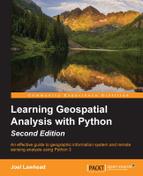As mentioned earlier, remotely-sensed raster data is a matrix of numbers. Remote sensing contains thousands of operations that can be performed on data. This field changes on almost a daily basis as new satellites are put into space and computer power increases. Despite its decades-long history, we haven't even scratched the surface of the knowledge that this field can provide to the human race. Once again, similar to the common GIS processes, this minimal list of operations gives you the basis to evaluate any technique used in remote sensing.
Band math is multidimensional array mathematics. In array math, arrays are treated as single units, which are added, subtracted, multiplied, and divided. However, in an array, the corresponding numbers in each row and column across multiple arrays are computed simultaneously. These arrays are termed matrices and computations involving matrices are the focus of linear algebra.
Change detection is the process of taking two images of the same location at different times and highlighting the changes. A change can be due to the addition of something on the ground, such as a new building or the loss of a feature such as coastal erosion. There are many algorithms to detect changes among images and also determine qualitative factors such as how long ago the change took place. The following image from a research project by the U.S. Oak Ridge National Laboratory (ORNL) shows rainforest deforestation between 1984 and 2000 in the state of Rondonia, Brazil. Colors are used to show how recently the forest was cut. Green represents virgin rainforests, white is a forest cut within two years of the end of the date range, red is within 22 years, and the other colors fall in between as described in the legend:

A histogram is the statistical distribution of values in a dataset. The horizontal axis represents a unique value in a dataset while the vertical axis represents the frequency of this unique value in the raster. A histogram is a key operation in most raster processing. It can be used for everything from enhancing contrast in an image to serving as a basis for object classification and image comparison. The following example from NASA shows a histogram for a satellite image that has been classified into different categories representing the underlying surface features:

Feature extraction is the manual or automatic digitization of features in an image to points, lines, or polygons. This process serves as the basis for the vectorization of images in which a raster is converted to a vector dataset. An example of feature extraction is extracting a coastline from a satellite image and saving it as a vector dataset. If this extraction is performed over several years, you could monitor the erosion or other changes along this coastline.
Objects on the Earth reflect different wavelengths of light depending on the materials that they are made of. In remote sensing, analysts collect wavelength signatures for specific types of land cover (for example, concrete) and build a library for a specific area. A computer can then use this library to automatically locate classes in the library in a new image of the same area.
